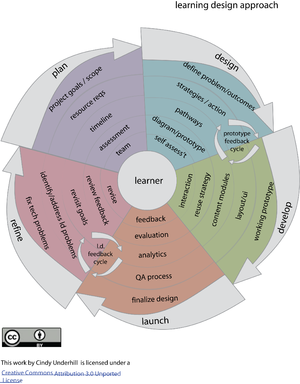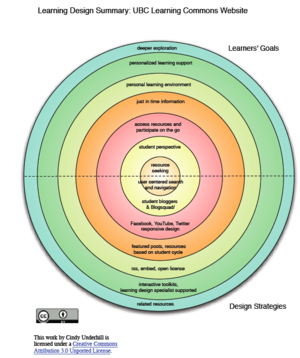Learning Commons:Student Orientation/Sessions/Frameworks
Your objective?
To answer (for yourself) 3 questions about learning design:
- What is it?
- Why is it important?
- How does it help us in our work?
Learning Design Overview
Definition
Simply put, it is the design of a learning experience. The purpose may be to support an articulated learning objective or intention or to address an expressed or defined challenge or problem in the learning environment. At its core is a consideration of the actions that learners may take in order to learn and design decisions are based on current knowledge about how people learn. Like all design processes, it is not linear, it is messy and involves trying things out, seeing what works, making alterations, and re-working. A key component is feedback and dialogue at every step in the process. Coming up with ways to represent the design ideas (or skeleton frameworks for discussion) are essential to the conversation. A good learning design is flexible, re-usable and adaptable to a variety of learning preferences.
Frameworks
| The Plan | The Reality | The Decisions |
|---|---|---|
 |
 |
 |
Discussion
The Plan
Take 5 minutes to discuss the last redesign of the LC website with the "Plan" framework in mind . If you weren't there, it will be your role to ask questions, did deeper. Reflect on the following questions. Document anything noteworthy in the discussions area.
- What parts of the learning design process did you feel went really smoothly?
- What did you struggle with?
- What would you do differently?
- What would you do again for the next web redesign (this summer)?
The Reality
Reflect on the development of the Toolkits with the "Reality" framework in mind . If you weren't there, reflect on the last time you were part of a collaborative creation process. Take 5 minutes to discuss and document anything noteworthy in the discussions area.
- What are the personal qualities that are important to bring to the process of learning design? Why?
The Decisions
Reflect on what you know about students and on your experience of the Learning Commons site so far. Take 5 minutes to respond to these questions:
- do these goals still make sense to you?
- is there anything missing?
Students need to know how to apply the information --> How do we accomplish this? Goal of the Learner: How can I do this?
Rethink the strategies we use for the personalized learning environment (RSS feeds for example)
If you think something is missing or needs a re-think, try to identify it, the strategy we could use to support it and the tie in with the learning principles referenced here.
Research that informed the decisions:
- Carnegie-Mellon's Principles of Learning
- opportunity for connection with others to discuss ideas and clarify thoughts supports learning.
- exploration of additional resources encourages personal "meaning-making" important for motivation.
Proposed Site Architecture
Your objective?
To apply what you know (or are learning) so far to:
- evaluate the relative merits and downsides of the proposed architecture for the new site.
- begin to map out a plan for the design phase based on the proposed site architecture.
Section Tabs
Proposed Changes
Tutoring & Studying
- Tutoring
- Peer Academic Coaching
- Improve Your Writing
- Academic Advising
- Study Spaces
- Workshops
- Approach To Learning: Self Assessment
- Live Well Learn Well
Student Toolkits
- Choosing Technology
- Thinking Critically
- Preparing for Exams
- Working in Groups
- Library Research
- Taking Notes
- Presentation Skills
- Interacting with Profs
- Reading Textbooks
- Managing your Time
- Writing
Resource Guides
- How to Cite Sources
- How to Find Articles
- Guide to Academic Integrity (change to Avoiding Plagiarism)
- Secrets of First Year
- Resources for Online Learners
- Resources for Faculty
Tech Support
- Computers & Software & Printing
- Assignment Calculator
- Tech Help
- Equipment Lending
About Us
Add Blog Archive on the Related links widget area on any blog post pages
What to consider regarding architecture
- Length of drop down should be roughly equivalent across categories
- Tab heading should be consistent in approach and single word preferable
- Try to take the position of someone coming to our site but wanting something to do with learning. So that tabs should give them hints as to what they can find. Looking through the tabs, you should have a sense of what the site is about without looking at what is beneath each heading
About
Start
- Secrets for First Year
- Guide to Academic Integrity
- Study Spaces
- 7 Things to Know
- Live Well Learn Well
- Resources for Online Learners
- Working with Profs and TAs Toolkit
Prepare
- Assignment Calculator
- Your Approach to Learning: Self-Assessment
- Time Management Toolkit
- Choosing Technology Toolkit
- Guide to Academic Integrity
Learn
- How to Cite Sources
- Note Taking Toolkit
- Library Research Toolkit
- Critical Thinking Toolkit
- Exam/Study Prep Toolkit
- Textbook Reading Toolkit
Create
- Equipment for Loan
- Tech Help
- Computers, Printers, and Scanners
- Presentation Skills Toolkit
- Group Work Toolkit
- Writing Toolkit
Support
- Tutoring
- Workshops
- Peer Academic Coaching
- Improve Your Writing
Discussion
Consider the proposed architecture and take 10 minutes to discuss:
- What are the benefits of this architecture? What will learners/users gain?
Creates a path for learners
- Drawbacks? What will they lose?
Really have to think about something to know what tab it's under
- Other considerations moving forward?
Need to test search function well
- Questions that we need to answer?
How do we deal with service oriented things in terms of the architecture
Your Mission
Focus on the design phase of the learning process. You have 20 minutes to dig into this together, 10 minutes to share what you have come up with so far and then (as a team) we'll decide how to proceed. From what you know of the learning design process so far (and using the frameworks as a reference), begin to map out a plan for the work we will need to start to do to design the site architecture. Consider:
- the questions that we need to address
- How flexible are the changes? If the navigation is easily altered, since we have feedback saying this is how we should do something, lets go for it provided it's an easy change
- What questions do we ask of people? What are we asking people to do? (Etc. "Find where you would print" vs. "Poke around and interact on the site")
- Do we need to set up redirects when changing the architecture since content is embedded in Arts web pages? --> Yes the changes are flexible but what's the impact?
- roles on the team
- Student Web Team: Building prototype, Carrying out assessment
- Staff Web Team:
- Full Team: Finalize categories and how the tabs are displayed
- prototypes
- Have a discussion to adjust a few things so that we are all in consensus before creating prototype
- feedback cycles
- How many people do we need to talk to to decide to make a change? Who decides what the critical number is?
- current users (strategies to minimize disruption)
- Do we have a notification that allows people to look at the beta and to inform them that changes are coming? Or do we just change it?
- anything else you think is important in this phase
Your Plan
edit the wiki page and draft out your plan here.
Wiki Overview
Julie's words of wisdom.
Close
Reflect on the opening questions.
Homework
- Flesh out the plan and pass off to Rie to integrate with her workplan for site re-design.